Cressbrook & Litton Flyfishers Club – Newsletter Autumn 2016
Tenancies renewed until 2026/7
We are pleased to announce that the Chatsworth and Bagshawe estates have agreed to the renewal of our leases for a further 9 and 10 years respectively. The Club enjoys extremely cordial relations with both our landlords, Tim Bagshawe of course having been our Patron for many years. Rents have been increased slightly, in line with inflation. We continue to be effective custodians, making steady improvements to the river and its surroundings for the benefit not only of trout & grayling but for all the wildlife of the Dale.
HILARY TO STEP DOWN
Hilary Langan has announced that she wishes to retire from the post of Hon Secretary at the AGM, a position she has held since 2011. Throughout her tenure she has served the Club with unfailing good humour and efficiency and has won many friends as a result. We thank her for all she has done for the Club and wish her many more fishing days in her retirement. We have been considering the future governance and management of the Club and envisage the eventual appointment of a general manager, reporting to the Committee, along the lines of the Piscatorial Society. With this in mind, we have asked David Marriott to absorb the Secretary’s role as a precursor to such an appointment. ~ Chris Austin President
THE SEASON IN RETROSPECT
This year we caught 12,272 fish which equates to 8.3 fish per visit. After last year’s heavy weed growth, the cycle turned and growth was less strong this year. This made for some challenging fishing during times when levels were low, particularly during the last few weeks. Fish tended to lie close to the banks and under overhanging cover as a result. That said, the weather was generally benign, with no extreme conditions to contend with this season.
Hatches of Large Dark Olives during the opening weeks gave excellent sport. Olive Uprights as usual gave great value for money and this year we had some very good hatches of Iron Blues. The Mayfly was good but not great, but for once the weather was conducive to successful spinner falls. The Blue Winged Olives continued to be the mainstay of our summer sport and Stoneflies were
out in numbers during the final weeks of the season. All in all a satisfying Season.
FROM THE COMMITTEE
The subscription for 2017 has been set at £990 and the joining fee remains unchanged at £750. Inflation is already being felt in fuel prices and the cost of stockfish, so the committee felt it prudent
to continue with its policy of modest annual increases. We remain competitive when compared to our nearest rivals. Invoices will be sent out towards the end of November with payment due on or before 1st January 2017. Those not intending to renew their membership would do our Membership Secretary a big favour by letting him know as soon as possible, so that he can begin the process of contacting those on the waiting list.
Now that the Chatsworth lease has been agreed for another 9 years, we are intending to replace the substandard fencing on Beat 8. The Original fence posts were not fit for purpose and have now rotted in many places. They have also been damaged by the buffalo as they roamed the fields in recent years. Our intention is to replace all the fencing and we hope to receive contributions towards this work from both Chatsworth Estate and the Environment Agency. This is a major project which we will be undertaking with our regular fencing contractor, Stuart Chapman of Taddington.
Other capital expenditure being considered is a new pick-up truck and the drainage of the Locked Bridge Car Park. We are also considering a replacement for the hut at Duffers.
NEW CATCH RETURN SYSTEM
We are fortunate to have very good relations with the Derwent Fly Fishing Club, with several members enjoying joint membership. Mark Ritson, one such member, has designed an online booking-in and catch return system for DFFC which has been in operation from the start of the 2016 season. It has worked very well and with some modifications it could easily be adopted by us as an online catch return system. It would have several benefits, not least of which being the elimination of the time consuming input of data from the catch return books to the spreadsheet by the Head Keeper. It will involve members in a little effort, in that they will need to log in to the website in order to record their catches. Catch returns can be completed online either from a smart phone or via a PC when you get home. Those who do not have access to a computer can either phone or text the Head Keeper with their catches, who will then make the entries on their behalf. Other members will not be able to view your returns but you will be able to see a day by day summary of your own catches. For the Club it will mean that up to date catch return information will be more readily available.
THE UPWING & STONEFLY SURVEY
Stuart Crofts reports that you have continued to support his survey magnificently with, if anything, more samples than last year. This is most gratifying, thank you. He is certainly going to be busy over the winter but he is confident that he will have a report ready for the Spring Newsletter.
A NEW CLUB TIE
Those of us whose membership goes back to the early days of the Club will remember that we used to have a club tie. This unremarkable piece of neckwear had on it a motif which can only be described as a cartoon trout. It was not a success. Our new President, Chris Austin, in his first executive decision, has decreed that we should reinstate this tradition but with a design more in keeping with one of the most prestigious fishing clubs in the country. The tie is of dark navy silk, superimposed with the our kingfisher logo. This high quality tie is available now for the very modest sum of £15. Contact Chris on austin.352@btinternet.com to place your order.


SPOTS BEFORE THE EYES – DON STAZICKER
This season the Club has stocked with rainbows and browns marked on the belly with a small blue dye spot. The object of this marking was to ascertain the proportion of stocked fish to native fish being caught by members and assess the effectiveness of stocking. My own experience of catching these marked fish has led to some interesting observations. This fish is a stockfish, it certainly looks like one to me, only it hasn’t got a blue spot.

I have found, as have others, that I am catching a lot of unmarked fish that, while in excellent condition, appear from their size and spot pattern to be stockfish. I feel there are two possibilities – these are stocked fish from previous years that have successfully overwintered or they are river-bred fish that originally came from stocking fertile fish in the past. We only stock with triploid fish and have done for many years. It is a little hard to tell with certainty if the rainbow you have caught is wild or stocked apart from the very small or very large specimens but there appear to be two distinctly different colourations of brown trout, those with many red spots and those without. The fish below has prominent red spots on its flanks and a much deeper yellow belly. It will be interesting to see next season if any of this year’s stock have overwintered. We intend to use a different mark next year to differentiate between stockings.

My own catches have been approximately 1 marked fish to 5 unmarked. This applies to both browns and rainbows. Up to the beginning of August we had stocked 1040 marked fish, of which 617 had been caught. Some may have been caught more than once but even so this can be considered a good return. I am really interested to hear of your own experiences with these marked fish and your own views as to what we are seeing here. Please email me at don@stazicker.co.uk
SEASONS END by Peter Arfield.

It may not be possible to catch the woody tang of a garden bonfire on an August evening without thoughts straying into poignancy. Another season of trout fishing on the rivers seems to be slipping away. “Plenty of time yet …” we tell ourselves but yet the high summer and the Dog Days already seem behind us as the odd heavy shower triggers a mist from the water at dusk.
There has never been a trout season as shortened by bad weather as this one. Still, we did need some water in our rivers and lakes, not necessarily in quite the deluge we received. The astonishing thing for my own half assed assessment seems to have been the amount and variety of the fly life we have seen this year. After two years of painfully low water and then heavy flooding, our up-wing populations seem not only to have survived, but thrived. Bernie has been sampling our fly life for years now, out in all weathers and with many other demands on his time. I don’t know how he and many others do it, and with good grace too. I must chat to him about population densities etc.
It seems a daft thing to say, but the Blue Winged Olives seem larger than usual – it may be that my new glasses are helping me more than I care to admit!
I was defeated on the water meadows one evening a few weeks ago. Skunked, dry-netted, water-licked as we used to say when on some expedition from the Sheffield works after whatever came long on the drains and rivers of Lincolnshire proved fruitless. That short evening gave me a taste of humility along with the wood smoke. Fish had been rising with some purpose in most of the
usual spots. Some runs on the river this season seem to have been devoid of rising fish, normally reliable swims too, showing fish in most conditions of water, from New year’s Eve, with a frosted coating across the windscreen, hoping the old van will actually kick over and burst into diesel powered clattering life, all the way into high summer and beyond. We have had to relearn the river this year. Soft repetitive rise forms, then some more urgent sub surface boils, air full of insect life. Spinners, duns,sedges, surely some trout will accept my fly – but no, not tonight and too dark now to change the fly, limbs creaking a bit as we stand up from behind some clump of vegetation or other, counting where nettles and tangy insects have left their mark. The bit of humility has to admit the presence of others who fish these waters, and those who no longer do, many with a much greater depth of knowledge, some with an almost instinctive understanding of what works on the complex flow patterns of the river as it broils along. And some, I suppose, who just need to be by the water for a while, who have too much to contend with in the rest of their lives to ever be anything but an occasional dabbler.
Walking back across the fields into the dusk, soft lighting from a leaded window in a property overlooking the water meadow, I sometimes wish I had paid more attention at school and maybe could have lived somewhere like that. But on some other evening, when the fly choice has been correct and the knots have held, and the casting has gone well enough, perhaps sharing the moment with an old friend, I have the sense of well being that “only anglers and honest men” can feel. Strange how thoughts can turn from words written four hundred years ago and still find truth in them.
And how another, more recent voice tells me “It ain’t dark yet, maybe that way”.
Maybe that’s what comes carried on the soft smoke of a garden bonfire, as dusk fall across the meadows.
These words come from a little homily given by Peter on the occasion of his birthday in July, at a gathering he hosted in Hebden Court for his many friends from the world of fly fishing. Ed.
STONEFLIES By Stuart Crofts
I already had a gut feeling that stoneflies were an important part of what is available for the fish to eat all season long on the Wye. But, after looking at my own data, the data from the “samples” collected by you, the members, and the keepers who do the routine Riverfly Monitoring for this wonderful fishing club it is now obvious that they are a significant part of the fishes’ potential menu.
Nonetheless, being on the menu is one thing, getting picked is another! The fish in general take food that is easy to catch using the minimum of effort. So where do stoneflies fit into this equation?
Do they take the nymphs? Do they take emergers? Do they take adults? Let’s have critical look at all these stages, starting with the nymphs. Well in general, these keep a pretty low profile and don’t often turn up in the stomachs of fish on the Wye. Next, the emerger. Well you can forget that because all our UK stonefly nymphs crawl clear of the water before emerging to the adult stage on dry land, plus this often happens in the dead of night. That leaves us with the adults – bingo! These are commonly found by the side of the river and the females of many species egg-lay at the surface in the afternoons throughout the season giving the fish plenty of opportunities to take them. Add to this the fact that all our common small and medium sized stoneflies are built to the same body
plan and we have an insect just crying out to be copied by fly fishers. All we have to do is vary size and colours to suit what we see. The following pattern is just my own take on this, all I can say is that it works for me. And, if you try it, I hope it works for you too.

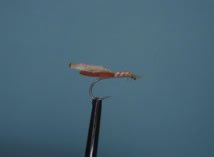
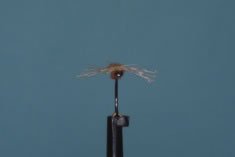
TIED & TESTED – BY STUART CROFTS
THE FLAT WINGED STONEFLY (detached body style)
Materials –
• Hook – Partridge SLD or similar in size 14 to 18
• Thread – 8/0 Unithread – colour to match body
• Body (detached) – Veniard Extra Fine Vernille Chenille – colour to match naturals
• Flat Wing – Poly yarn – colour to match naturals
Tying sequence for this fly –
Start the thread just behind the eye (leaving a small gap) and work down the hook. At a point 1/3rd of the way down the hook lift in chenille as a detached body and position so the it just overhangs the bend (if you like this can be lightly passed through a lighter flame first to slightly taper it). This is then locked in place with a couple of turns of thread. Lift up the chenille and work the thread
back towards the eye, just two or three turns – then tie down chenille again. Repeat this and then when just behind the eye cut off waste chenille. The chenille will now be secure and have “valleys” made with the tying thread (see sketch below showing the tying thread “valleys”).

Work the thread back to the initial chenille tying in point following the “valleys” in the chenille. Take a length of poly yarn. Cut a nice square edge and then hold the poly in some flat nosed pliers with the square edge protruding about 3mm. The exposed edge is then melted with a lighter flame. You now have the flat wing ready for tying in.
Lift in the flat wing so that it just overhangs the detached body. Now, you can go one of two ways A or B: This is for when you DO NOT intend to use Bug-Bond to seal the thorax. So, to continue….secure the wing on top of the detached body by once again following the valleys and then with waste wing pointing over the hook eye tie off the thread. You can now thin out and trim the waste wing pointing over the eye to create a sparse “leggy” effect.
This is for when you DO intend to use Bug-Bond to seal the thorax when the fly is complete. So, with this choice ….. secure the wing on top of the detached body working towards the eye and once again follow the valleys but this time allow a few of the wing fibres to kick out sideways, as legs, as you go. When you finally reach the point just behind the eye you can now tie off the fly and cut away all the excess waste wing fibres leaving just a few at either side of the thorax. Last, carefully apply a little Bug-Bond on the top & bottom side of the thorax area and zap it. This will consolidate the “leggy” effect and prevent these, and the wing fibres, from getting pulled out. The wing itself can be left as a single or split with scissors to give a double wing effect.
Attributes of fly plus notes –
• Use whenever fish are taking any of our stonefly species of spring, summer and autumn. The simple message is to always keep your eyes open for stonefly adults all season long (different species have different flight periods).
• Just change the size and colour of the pattern to match the types that you see on your river.
• Best used as a single fly on a fine tippet. Cast accurately and try to get a drag free drift, however if this fails then try a slight twitch of the fly every now and again. But, watch out, as this often provokes very savage takes!
OF GREY FLIES & BROWN by Colin Dimond
The day started well as, on arriving at the Locked Bridge, we saw fish rising in front of the Hut. A kind guest angler informed Alan and I that fish were rising upstream where he was fishing so we decided to venture downstream to where I had experienced a massive black gnat swarm the previous week. Passing through “Heaven’s Gate”, the natural arch of hawthorns, we proceeded to the
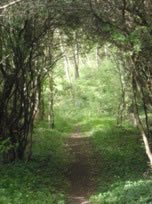
pool above the island where I’d seen the black gnats. We were greeted by rising fish. Seeing Alan settled in a good spot, I went a couple of runs downstream and on went the Quigley’s Cripple, a fly Alan had named the Grey Fly. After landing my second brown Alan passed by on his way downstream, informing me he had caught a lovely rainbow on the Grey Fly.
persevered to no avail and duly followed Alan, soon catching up with him in the pool where Chris had tethered the fallen Ash Tree. He didn’t seem to be doing too well, so I continued downstream. When walking past the bench, I noticed an Olive Upright, then many more, their distinctive tails and large size making them easy to identify. A quick look in the box and a size 16 Duck’s Dun of the correct colour and size to match the hatch just jumped out at me. A couple of casts later I had a positive rise and found myself hooked into a mad rainbow. It screamed around the pool just to the left of the small island and three times I had it drawn to the net, only to have it push off and take line again. When I finally got it in the net I was surprised not only by its perfect condition (I never cease to be amazed by our gorgeous wild rainbows) but also by its diminutive size – I’d thought it was double its pound an a half!
Two browns later, Alan appeared. I gave him an example of the Duck’s Dun, which he called the Big Brown Fly. When I crossed the river above Twin Pools a little later I saw Alan struggling to subdue another rainbow, hell bent on avoiding capture. With Alan’s permission, I went in above him to fish the run-in, which is a favourite spot of mine. Then Alan was in again, this time a beautiful brown of around 2 lbs, the best fish of the day. As he was releasing this fish we were greeted by the noisy arrival of the Head Keeper and the grass cutter. Whilst we chatted, there was a hoot from a passing white van – you’ve guessed it, the EHK had made an appearance! It was clearly time for a break and a glass of wine, so we headed back to the Hut. Before we got there, after re-crossing the river, a good fish could be seen rising on the inside of the bend. Alan couldn’t resist – first cast, fish on and the classic comment “good fly this Brown Un!” We agreed that life was
good.
Over lunch we were joined again by the guest angler. He said there were fish everywhere but he could not get them to take his fly. Alan immediately suggested I give him one of my “Brown Flies”, which I duly did. We finished our wine and went our separate ways, Alan working his way up to Quaker, whilst I started immediately above the bridge. I had four in quick succession, all browns – and yes, to the Brown Fly. I then took my best of the day, another brown close into the bank, having carelessly showed its presence. I had one more rainbow from the flats and then unfortunately the sun started to blaze down and put paid to any further sport. Alan arrived, having had just one more, despite Quaker Pool being alive with fish. Soon we were joined by the guest and guess what, he’d had a ball with the brown Fly! A fitting end to a great day.

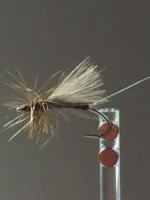
FAIRWEATHER FISHERMAN? by Carl Brumby
To mark my 50th birthday I decided to see if I could fish all beats of the river in a single day, something I had never previously attempted. The conditions looked great with 20mm of rain a couple of days previous and a clear forecast for my day on the river. I knew to cover all 8 beats I would have at best around an hour on each beat with travel between completing my available time.
I arrived at beat 1 car park for around 8:00am with bright conditions and the river more coloured than expected, to an extent that I thought the lower beats might in fact be unfishable. I headed off
downstream and noted clouds of very small midges or greenfly in the air. With no sign of rising fish I opted for an upstream nymph and soon had a handful of rainbows and browns so headed back to the car and moved down to Duffers.
Again the water was coloured so for ease I stayed with the upstream nymph. Bill Ryan shortly pulled up with his guest and we had a brief chat when Bill pointed out the rough location of a rather nice brown. Fishing upstream nymph is a very good way of covering water, like fishing dry fly blind, and unbeknown to me I soon covered the brown only for it to rise to my indicator! It was now
that big dark clouds appeared, a brief spell of rain I presumed, the BBC have such an accurate forecast don’t they!
next moved down to the car park at Freddies with rain now pouring and the river coloured. Still persevering with white headed nymphs, a couple of fish came to hand above the weir. I ventured downstream to a spot where a guest of mine had surprised me by wading to a hot spot. This run was otherwise very tough to reach but it just shows the benefit of a fresh pair of eyes and an open mind. A few more fish were taken here.
Presidents proved its usual self despite the pouring rain. It was now around midday and I was seeing the day trippers out in shorts and t-shirts equally as surprised as me at the inaccurate forecast. Indeed one lady was content enough to use a large rhubarb leaf and stem as an umbrella!
Beat 5, the car park at Netherdale was empty and a brief respite in the weather had me thinking my waistcoat would soon dry out with a few hours sunshine. Gregory’s had a few nice fish rising so I opted for the dry. No sooner had my first cast gone out than the rain started again. Too much for the CDC to take so the nymph went back on. Interesting though that the water here was in fact clearer than upstream. Beat 6 had a cracking olive hatch in the dale with a few fish taken on the dry.
Beat 8 next and there were no cars at the Bobbin Mill. Upstream below the weir proved successful with a couple of grayling taken at my feet, so close that I had to push the rod away from myself to gain an effective strike! I next headed for Locked Bridge but the car park was packed so I moved to Newbridge. Fishing up from the bridge I picked up a few fish on nymph and dry.
Most fish in the upper beats with coloured water took a fox squirrel nymph or black iridescent nymph, both white headed tungsten, and lower down in the clearer water to a dark headed nymph of similar pattern.
The fox squirrel nymph is a well-documented fly on the Wye but the iridescent nymph is less so. One of Phil Holding’s patterns, it simply uses Veevus Iridescent I001 as a body and is finished with UV cure varnish. Fished down to #22 it works well with a variety of bead colours.
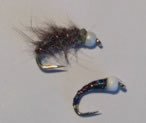
It was a day that will stay with me for a very long time. Fantastic fishing with plenty of fish throughout the river, despite the appalling weather. In the face of such weather conditions it’s worth backing a broadly considered view that the Wye is rarely unfishable. We should also be mindful that it can take up to 6 hours for floodwater to reach the lower beats so it can pay to fish these first.
I wrapped up at around 18:30 and headed off home, still in the pouring rain.
LAST CAST
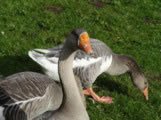
Anyone who fished at Duffers this year will know that we have been adopted by a family of geese. Despite having been looked after by Chris Thirtle and protected by him from the local hill-billies who have tried to run them over, they have shown little gratitude to members. There aggressive hissing, pecking and s******g has hardly endeared them to us, so you will probably be pleased to know that Chris will be removing them before the start of the Season. Let’s hope they don’t have a homing instinct.
That ruggedly handsome hirsute bloke
Towards the end of the season, you may have spotted a bearded, suspicious-looking character

lurking about the Huts, begging for food. In many ways he was more of a nuisance than the geese, sometimes blatantly coming into the huts and stealing food, as when caught here red-handed on camera by Nigel Calladine.
Wildlife Criminals
Depressingly, we have once again been targeted by poachers, although the perpetrators seem to have been less aggressive this year. The keepers have been successful in apprehending most of them, working closely with the police and neighbouring keepers. At Chesterfield Magistrates Court recently, five men were fined (including costs) an average of £500 each. One, a repeat offender, was also fined for not having an Environment Agency rod licence. An untaxed and uninsured vehicle used by the criminals was also confiscated by the police.

Chris Thirtle has done an excellent job in building up our relationship with the police, who are now starting to take wildlife crime seriously. Recently he spent a day patrolling the river with our local PCSO, Ian Phipps and Derbyshire’s Police & Crime Commissioner, Hardyal Dhindsa.
Two wings good?
Our attention is generally focused on the upwing flies for which the Wye is justly famous, but take a look at this smorgasbord of dipterans taken by a fish caught by Peter Hayes recently. It was targeting chironomid pupa but it also took a housefly or two. Peter is curious to know whether the fish was taking chironomids on the point of hatching, or whether it was taking the empty shucks, which seem to outnumber the actual

adults. Either way, we should be aware that trout are opportunistic feeders and will generally concentrate on the predominant food source.
You can view this newsletter as a downloadable PDF by clicking here
